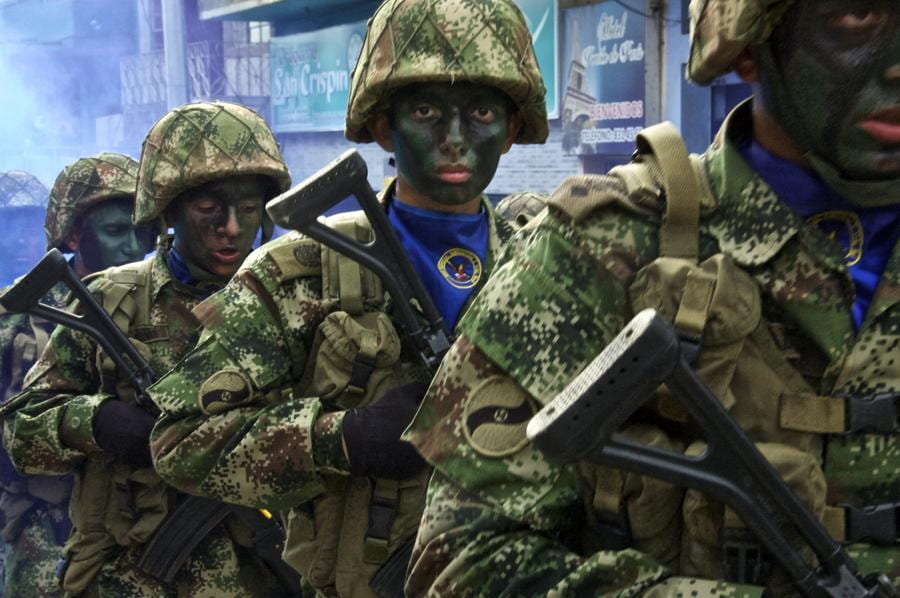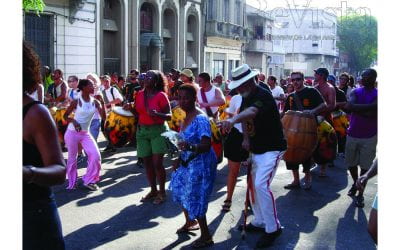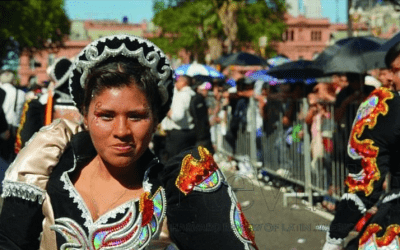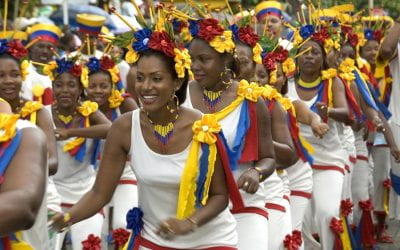The Fiesta Must Go On
For more than 150 years, gold mining has been the life-blood of Segovia, a town in central Colombia that sits atop a labyrinth of underground tunnels where miners toil. Above ground, hordes of motorcycles choke the streets, lights whirl from casino storefronts and beats pulse from steamy discotecas from night into the morning every day of the week.
Every year, this wild-west-like town eagerly awaits its week-long festival celebrating gold mining and honoring the Virgin of Carmen, the patron saint of miners.
Days of parades feature fantastical carnival costumes, school marching bands and elaborate floats, each one representing a different mine that showcases its wealth with its ostentatiousness and level of preparation. Miners compete in sporting events and race against each other with 110-pound bags of rock on their backs. Every night, the main plaza fills with concert-goers and the bars swell with patrons. Ultimately, it is one great, long party.
The first time I went to Segovia’s gold parties was in July 2012. At the time, Segovia was in the throes of a regional war between two armed groups fighting over the territory and its gold mines. Homicide rates had tripled. Multiple funerals a day, in a town of 50,000, became routine. Fear hovered over Segovia’s streets and seeped into its porous underbelly. The weekend of the gold festival, even the funeral home’s driver showed up at the morgue, dead in his hearse. Everyone realized they weren’t immune to the violence. Many people were too afraid to head into the streets to celebrate—“and celebrate what?” they asked. “The killings? The massacres?”
For others still, the parties took on a greater importance because of the violence—an opportunity for Segovia to show thatalegría could trump fear, and that its party spirit would not be snuffed by a war in its midst. “Segovia needs these parties this year,” one community leader told me. “The fiestas have to go well.”
The week of the fiestas, Segovia teetered between revelry and tension but then triumphed in being a grand spectacle. On Colombia’s Independence Day, military paraded through the streets, their menacing face paint and show of force made almost farcical in a town where state armed forces had no control in the face of paramilitary groups.
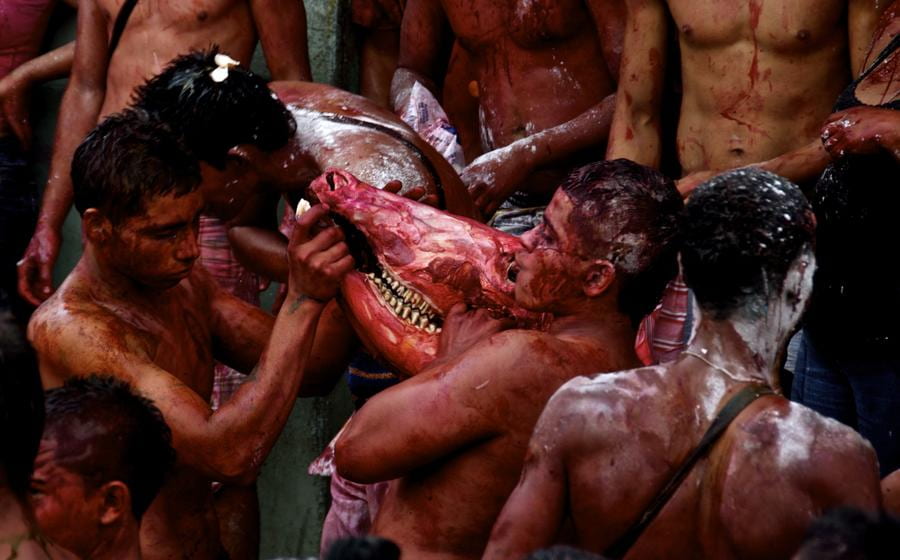
Segovians smear each other with a red dye and run through the streets, shown here with a cow head, August 2013.
One day, hundreds of Segovians participated in the annual carnival tradition of smearing moresca, a red liquid, over each other, a screaming flush of euphoria. People told me the red liquid symbolized blood, and that gold mining both required it as a sacrifice and, as evidenced by the violent bloodshed up to that point, brought it to their town. As Segovians drenched each other in the fake blood, it looked like the town was performing a dramatization of its own reality, residents careening through the streets as though they were running away from their own massacre. The bacchanal roared on for days.
The following year, much had changed in Segovia. A few months prior, the battling armed groups came to a pact, and the homicide rate dropped like a stone. But other problems followed. A miners’ strike forced Segovia to postpone its festivals until the next month. But then, the strike reignited amidst nation-wide protests. Violent clashes endured for days between police and protesters. Stores shuttered, tires burned in the streets and all roads connecting Segovia to the rest of the department were blockaded. A state of emergency blanketed Segovia and yet again, the gold festival was in jeopardy.
Segovia’s mayor allegedly paid for the thousand-plus protesters camping out in the town’s coliseum to move en masse to another town so that Segovia could carry on with its party plans. This year, people questioned if it was right for Segovians to revel while hundreds of thousands of miners and campesinos across the country were making sacrifices to collectively stand up for their rights.
Could Segovia prepare for its fiestas so last-minute and under these conditions to do so? More importantly, did it have the spirit to? Questions murmured on the barricaded streets.
When the festival’s organizers announced the fiestas would persevere but without many of its key events, revelers-in-waiting clamored for their re-installment. What kind of festival would it be without the Gigantona, the huge carnival doll who chased after red liquid-crazed denizens? Imposible! Certain festival traditions were too important to forego.
Again, Segovia needed its fiestas. In fact, it deserved them, the mayor said, and nothing would get in their way. Hastily, the town pulled them together. This year, the crowds were thinner. Confusion reigned over the festival, congruent with the general state of upheaval and uncertainty that Segovia had been living. The year and a half or so of violence had battered the town’s economy, and merchants and miners didn’t have much money to contribute to the fiestas. On top of that, many were driven out by the violence, taking their money with them. The floats representing different mines were far fewer and less boastful —money was scarce and there had been little time to prepare. Outside talent often couldn’t arrive due to blockaded roads.
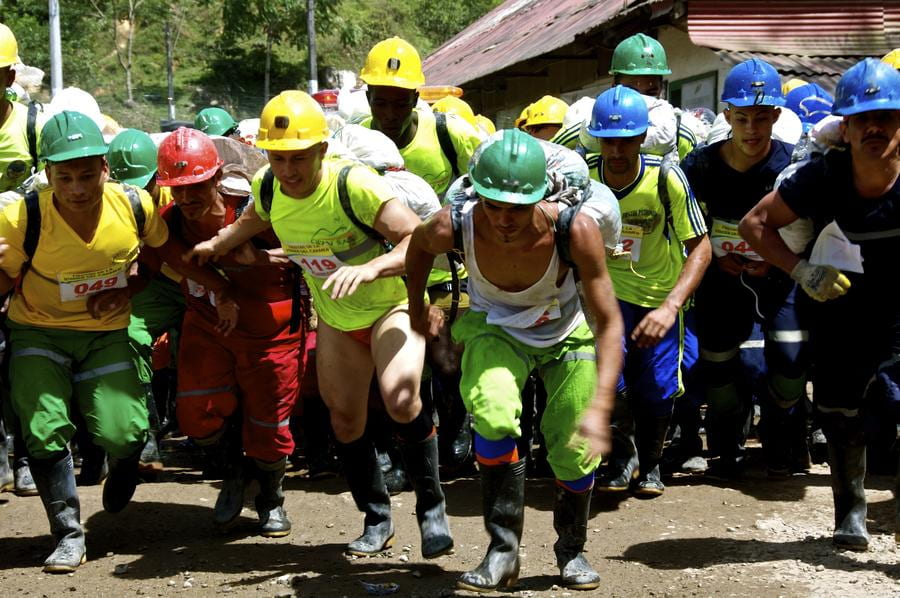
Miners called “catangueros,” whose role in a mine is to carry the rock out of the tunnel, race against each other in a yearly competition carrying 50 kg bags of rock on their back (July 2012).
But Segovia pulled off its festival, and Segovians partied long and hard, though brushed by a current of weariness. That year, people told me that moresca, the red liquid they cover themselves with, had nothing to do with blood; it was simply a festive liquid used in carnivals all over Colombia.
With the fiestas, the streets convert into a stage where outsiders like myself see a piece of theatre that unfolds Segovia’s story. Segovia sure likes its fiestas, but they also serve as a barometer of its political, social and economic climates.
Spring 2014, Volume XIII, Number 3
Nadja Drost is a Canadian multimedia reporter based in Bogotá, where she contributes to Canadian, American and European publications and radio programs. She is carrying out a long-term reporting project on gold mining and the armed conflict; her reporting in Segovia has been supported by a fellowship from the Alicia Patterson Foundation.
Related Articles
Fiestas Madriguayas
English + Español
I’m writing this story from the neighborhood of Barrio Sur in Montevideo, Uruguay. The lively pulse of the candombe drum reaches me from the streets. This Afro-Uruguayan rhythm…
Bolivians in Argentina
English + Español
In 2007, while living in Brazil, I decided to take a short trip to Argentina to attend the Festival of Independent Film (BAFICI) held every April in Buenos Aires. I looked forward to …
The Fiestas de San Pacho
The Fiestas de San Pacho (St. Francis of Assisi) in Quibdó, El Chocó, Colombia, are sixteen days of barrio-based parades and religious observations (and, in fact, less well-known activities…

